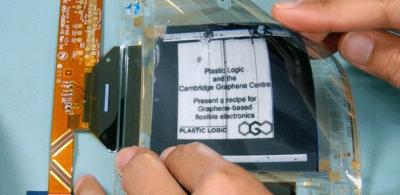UK-based FlexEnable was spun-off from Plastic Logic in February 2015 with an aim to further develop and commercialize the company’s technology platform for organic thin film transistor (OTFT) arrays for flexible displays and ubiquitous sensing. Last month FlexEnable joined the graphene flagship, and announced plans to develop new use cases for graphene in flexible electronics.

I talked briefly to Mike Banach, FlexEnable's Technical Director, and he explained the company's graphene plans and goals. FlexEnable is not a material company - they do not aim to develop and produce graphene material. The define themselves as a applied process technology - what we call a graphene application developer, focused on the flexible electronics market.
In June 2013 Plastic Logic started researching graphene for flexible displays in collaboration with Cambridge University's Graphene Centre. In September 2014 they presented the first prototype device - an E Ink display that uses graphene as a transparent electrode. FlexEnable is still pursuing this research, and now aim to apply the same technology for other display platforms (including organic LCDs and OLEDs).
FlexEnable has more ambitious plans for graphene, though. The company is very interested in using the highly conductive material as the basis for the actual display backplane. OTFTs offer many advantages over silicon or Oxide-Metal TFTs - they are easier to process in lower temperatures and are highly flexible. However, graphene and related materials has the potential to create a step change in the performance you can achieve with flexible transistors.
Graphene, in its natural state, does not have a bandgap. FlexEnable is looking into two alternatives to create transistor behavior. One is using other two dimensional materials that do have a bandgap - such as MoS2 for example. As of today, these materials are not as easy to source as graphene, so their use in industrial labs are only now starting to emerge.
Another option is to introduce a bandgap into graphene. This can be done in several methods - for example using graphene ribbons. A main reason why FlexEnable joined the flagship was to find development partners for novel types of graphene that can be used in flexible backplanes.